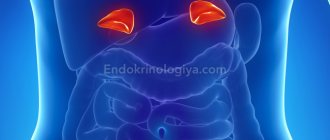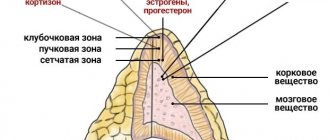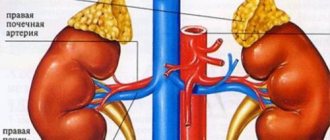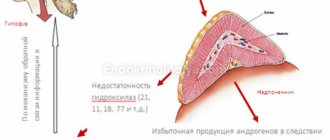Home / Endocrinologist / Treatment of hormonally active adrenal tumors
Hormone-producing tumors of the adrenal cortex are one of the pressing problems of modern endocrinology. Hormonally active adrenal tumors are a group of neoplasms that cause increased secretion of a particular hormone by glandular cells. They are divided into benign and malignant.
Classification of hormonally active adrenal tumors
There are 5 main types of hormonally active adrenal tumors:
- aldosteroma (violation of water-salt balance), causes primary aldosteronism.
- glucosteroma (metabolic disorders), clinically manifested by Itsenko-Cushing syndrome.
- androsteroma (increased male hormones in women), leads to the development of virilization in women.
- corticoesteroma (increased female hormones in men), causes gynecomastia and virilization in men.
- glucoandrosteromes (mixed).
In addition to the above classification, all neoplasms of the adrenal glands (cortex) are divided into:
- benign (adenomas),
- malignant (carcinomas).
This division is also important, since surgical removal of the adenoma is accompanied by almost complete recovery.
Forecast
If a benign adrenal tumor is removed in a timely manner, the prognosis is only favorable.
After removal of an androsterome tumor, characteristic short stature may remain.
After removal of pheochromocytoma formations, phenomena such as hypertension and tachycardia may persist, which are eliminated through appropriate therapy.
With benign corticosteroma, already a month after removal, the patient’s appearance begins to change, weight decreases, stretch marks fade, sexual functions are restored, etc.
If the formations are malignant and metastasize, then the prognosis is very negative.
Symptoms of hormonally active adrenal tumors
1. Aldosteromas are characterized by certain cardiovascular symptoms:
- headache,
- arterial hypertension,
- dyspnea,
- interruptions in heart rate,
- increase in the mass and volume of the damaged organ,
- myocardial dystrophy,
- changes in the fundus of the eye, manifested in hemorrhage and swelling.
When a crisis occurs:
- suffocating vomiting
- pain in temples,
- myopathy,
- uneven breathing,
- darkening of the eyes.
As a rule, the complication is a stroke or acute coronary insufficiency.
Neuromuscular symptoms:
- convulsions,
- muscle weakness,
- dystrophy.
Kidney symptoms:
- dehydration of the body,
- alkaline urine reaction,
- Frequent urination day and night.
2. The symptoms of corticoesteroma are identical to the manifestations of Itsenko-Cushing syndrome, namely:
- obesity,
- pain in the temporal part of the head,
- rapid fatigue and excitability,
- muscle dystrophy,
- steroid diabetes,
- sexual dysfunction (decreased potency in men due to testicular hypoplasia),
- the appearance of bruises and stretch marks in the chest, abdomen and thighs,
- women experience excessive hair growth, like men, decreased voice timbre,
- pyelonephritis,
- urolithiasis disease,
- depression,
- early puberty in young girls and, conversely, delayed puberty in boys.
3. Symptoms of androsteroma:
- early sexual development in children,
- acne all over the body,
- menopause,
- increased libido,
- the timbre of the voice decreases,
- drying of the mammary glands,
- uterine hypotrophy.
4. Symptoms of glucosteroma:
Clinically, a tumor of this type is manifested by a complex of symptoms united under the name Itsenko-Cushing syndrome.
Itsenko-Cushing syndrome combines a number of other symptom complexes, which we will discuss below.
- Dysplastic obesity. It is characterized by the peculiarities of fat deposition: on the face (the so-called “moon face”), in the shoulder girdle, lower back and abdomen.
- Hypertensive syndrome. High blood pressure is accompanied by intense headaches and is often accompanied by arrhythmias.
- Heterosexual syndrome, secondary hypogonadism. In men, libido and potency decrease, the testicles atrophy, in women virile syndrome is formed: the menstrual cycle is disrupted up to amenorrhea, the mammary glands decrease in size, the external genitalia hypertrophy (the clitoris increases in size), and excessive hair growth (hirsutism) is noted.
- Myopathy. It is characterized by a sharp atrophy of muscle tissue, this is especially noticeable in the extremities: due to myopathy, they look sharply thinned.
- Systemic osteoporosis. Patients complain of constant pain in the bones and a tendency to frequent fractures that do not heal for a long time.
- Trophic changes in the skin. They are represented by multiple striae (stretched stripes of crimson or purple skin) in the area of the mammary glands, lower abdomen, inner surface of the shoulders and thighs.
- Encephalopathy, astheno-depressive syndrome. It manifests itself in the form of memory and sleep disturbances, constant lethargy, sudden mood swings, emotional lability, depressive states up to the development of psychosis.
- Secondary immunodeficiency. Occurs in approximately 2/3 of patients and is characterized by an increased susceptibility to all kinds of infections and slow recovery.
- Disorders of carbohydrate metabolism. Occurs in 80% of patients with corticosteroma. They are characterized by an increase in blood glucose levels, both transient and stable (steroid diabetes). Ketoacidotic conditions develop extremely rarely.
Note that the development of adrenal tumors can also be asymptomatic. Such cases occur in almost 10%. They are identified during mandatory medical examinations or when contacting a specialist for examination of another disease.
A benign tumor can acquire a complication, which manifests itself in the fact that healthy cells acquire the properties of patients, thereby destroying the organ. Malignant formations affect neighboring organs (lungs, liver and even bones).
Causes
As already mentioned, doctors are not yet able to identify the specific cause that provokes the onset of the disease. But they know exactly what symptoms and treatment are typical for the problem under consideration. The following patients are at risk for this pathology:
- Having a congenital pathology in the structure and functioning of the organs of the endocrine system: the pituitary gland, pancreas and thyroid glands.
- Persons whose immediate relatives suffered from a cancerous tumor that arose in the lungs or mammary gland.
- With hereditary hypertension.
- Having kidney or liver diseases.
- Having previously had cancer of any other organs.
- Injuries.
- Chronic stress.
- Arterial hypertension and more.
Diagnosis of hormonally active adrenal tumors
To check the hormonal activity of adrenal tumors, a diagnostic method such as venography . It involves inserting a venous catheter into the adrenal glands and then drawing blood.
The activity of tumors is checked by a routine urine test (the amount of cortisol, cotecholamine and certain acids). Donating blood for hormones before and after taking medications and measuring blood pressure are also ways to diagnose hormonally active adrenal tumors.
Prevention
Preventive measures are aimed at eliminating the possibility of relapse of the pathology. At the same time, achieving this goal is quite difficult, since the true reasons that provoke the development of adrenal tumors have not been established.
If the formation has not begun to metastasize, then the patients’ vital functions are restored: previous fertility indicators and other things return. After surgery, patients are recommended to:
- exclude the use of sleeping pills and alcohol;
- monitor your nervous and physical condition, avoiding overexertion;
- follow a diet, limiting the consumption of fatty and spicy foods.
It is also necessary to visit an endocrinologist every six months in order to correct restorative therapy and prevent relapses. If any problems arise, you should consult your doctor promptly.
Treatment of hormonally active adrenal tumors
Once a diagnosis has been established, the first-priority treatment method is surgical removal of the malignant tumor and adjacent tissues affected by it. After surgery, chemotherapy and radiation therapy are possible.
In some cases, careful monitoring is carried out. It is not advisable to self-medicate; therapy is prescribed only after visiting a doctor. For prevention, adhere to a healthy lifestyle and do not drink alcohol.
Which doctor should I contact in Aleksandrov?
Hormonally active tumors of the adrenal glands are the area of interest of the endocrinologist. However, patients often turn to a cardiologist for the first time with complaints of high blood pressure or to a gynecologist with problems of amenorrhea and infertility.
These specialists may also suspect adrenal damage and refer the patient to an endocrinologist. In case of osteoporosis, consultation with a rheumatologist is indicated. When fractures occur, they are treated by a traumatologist.
In our clinic in Aleksandrov you will receive a consultation from a qualified, experienced endocrinologist and will be able to undergo all the necessary tests at a time convenient for you. Registration by phone: 8 (49244) 9-32-49.
Diagnostic measures
Scheme of tactics for patient management in case of accidental detection of an adrenal tumor. 17-OX - 17-hydroxycorticosteroids, 17-KS - 17-ketosteroids. Both substances are metabolites of steroid hormones.
Detection of a hormonally active neoplasm is based on:
- clinical symptoms, especially identification of characteristic signs of adrenal tumors in women and men;
- laboratory data: hormone levels in the blood and urine, determination of electrolytes in the blood;
- conducting pharmacological tests: with dexamethasone, spironolactone;
- instrumental methods: ultrasound, CT, MRI.
Important! Ultrasound diagnostics is good for the initial determination of the presence or absence of focal pathology of the adrenal glands. More accurate data is obtained by performing computed tomography and magnetic resonance imaging, especially with the use of contrast enhancement.
In the case of a hormonally inactive tumor, most often the tumor is accidentally discovered and further examined. For such formations the term “incidentaloma” is often used (from the English incidental - accidental).
Algorithm for diagnosing adrenal incidentalomas using ultrasound, CT and MRI










